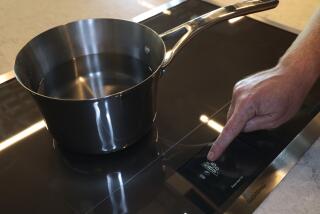Appliance Labels Give Ratings of Efficiency
- Share via
QUESTION: We’re remodeling our kitchen and plan to buy a new dishwasher and refrigerator. I’ve been browsing for these and wonder what to make of the EnergyGuide labels? I’m having a hard time making sense of them. Please explain.
ANSWER: New home appliances offer greater energy efficiency than older models. You can take advantage of this by using the EnergyGuide labels when shopping.
EnergyGuide labels will help you compare the energy costs and energy-efficiency ratings of appliance models in similar sizes.
The labels (bright yellow) must be prominently displayed on the front of new appliances including: water heaters, refrigerators, refrigerator/freezers, freezers, clothes washers, dishwashers, air conditioners, furnaces, and heat pumps.
The label information is based on a standardized efficiency test conducted by independent, nationally recognized testing labs.
You may find that a less expensive appliance costs more to operate when compared to another model of the same size. It generally makes sense to spend more money initially to purchase an energy-efficient appliance as you’ll save monthly down the road.
For example, an inefficient refrigerator might cost $30 to $40 more per year to operate than a highly efficient model the same size.
Is Floor-Radiant Heat Safe Under Carpets?
Q: Please explain floor-radiant heat, so I can decide if it is safe for my new condo, which will soon be built. What does it do to carpeting and under-pad threads (will it melt them?). Is it adequate heat for cold days? How warm can it be? Is it clean or is it expensive?
A: In a floor-radiant heating system, hot water pipes or an electric heating element is placed in the lightweight concrete or beneath the wooden floor surface. A properly installed system will be more than capable of providing adequate heat to maintain comfort. It will also be very safe and clean.
The advantages of the system are: it can be easily zoned and it does not interfere with draperies or furniture placement. Some people really like the feeling of a warm floor on bare feet. Others point out that you don’t have to see or hear the heating system.
The disadvantages tend to be that it is a different type of heat than you may be used to and it can take a fairly long time for the house to get comfortable after the system has been set back for any prolonged period. Heavy carpeting can interfere with the delivery of heat.
The systems are generally of two types. In one system, synthetic piping is laid down over the floor surface and then covered with a lightweight concrete. The piping will carry heated water. The water may be heated by gas, oil or electricity. The cost of the fuel and the efficiency of the boiler will determine how high your heating bill is.
If something were to break the piping, repair could be very expensive. The system is pressure-tested before it is covered, so breakage shouldn’t happen. The maintenance cost would also depend on the required maintenance for the boiler.
In another system, electric cables are laid, similar to the pipes above. A variation on this system uses a conductive grid encased in a sheet of film about 12 or so inches wide and of any length.
This system is used under a wood floor, such as parquet. The grid and film heating elements are designed so they will not short out the entire electrical system or cause a bad shock if a nail or screw were driven through one. Because these systems are built into the floor itself, repair of the element could be expensive.
As with the piping above, the main connections are usually made accessible. Properly installed, they are no more dangerous than the other electrical wiring you will run in your condo.
Either approach should be very clean in your living area. Newer systems use lower wattage, so dirt is not baked onto the surface. The temperature will be low enough that your carpets will be fine. Some people feel floor radiant is more efficient because the air is not heated, but the objects in the room and floor surface warm the occupant.
We think this is less important than the zoning the system can provide. When they are zoned (controlled to heat separate rooms to different temperatures), the systems sometimes are more efficient than furnace systems with one thermostat.
Produced by the Washington Energy Extension Service, a division of the Washington State Energy Office. Reader questions cannot be answered individually. Questions of general interest will be addressed in this column.
More to Read
Inside the business of entertainment
The Wide Shot brings you news, analysis and insights on everything from streaming wars to production — and what it all means for the future.
You may occasionally receive promotional content from the Los Angeles Times.










